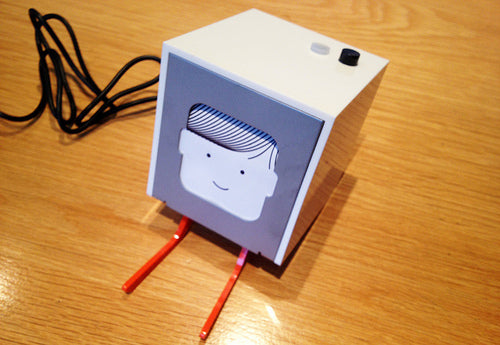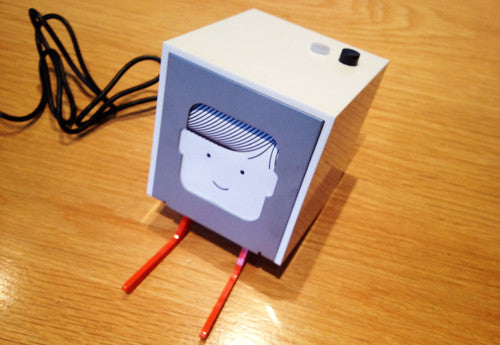
The Printer’s Tale

I went to a fascinating evening of talks called ‘The Printer’s Tale’ at Decoded the other night. The plentiful wine and mince pies were enough on their own to spread cheer, but the talks were equally enjoyable, looking at how print is combining with digital. Or is it digital with print? Arriving early I met a woman who had been running a magazine workshop with schoolkids. She bemoaned their lack of magazine experience, a gentle reminder of the ‘end of print’ elephant in the room.
The six speakers had ten minutes each, long enough to say something but not too long. Co-organiser John Ridpath got things started with a look at Decoded’s CodeCards, a system to enable non-coders to to code using cards, a glass table and a video camera. The metaphor of coding as word puzzle works well. I liked his pick-up of the phrase ‘Programme or be programmed’ in reference to the importance of understanding coding.
If this seemed to be taking the print-digital combination a little far, the remaining presentations more than made up for it. A big reason for attending was to hear from Alice Bartlett from Berg about their Little Printer project. I’ve had one of these cuboid devices on my desk for a couple of weeks now and not had time to play properly but Bartlett inspired me to get on and do so.
Berg are a healthy combination of the fantastic and the daft. While consulting with major clients they continue to develop spin-off projects that are always intriguing but also experimental enough that they sometimes fail. Their comic project SVK didn’t live up to expectations, for instance, but their early protyping of the Mag+ iPad magazine app tool contributed much to the early days of iPad publishing (and continues to do so via the live tools still used by publishers).
It remains to be seen which side of the equation Little Printer falls. The thinking is cute – a till receipt paper based printer that ‘publishes’ material you select from a browser-based dashboard. Being open-source, anyone can use their API to provide content to the owners of the device. Alice explained it as creating a narrow (ie till-paper width) website that could share a screengrab for printing via the Little Printer. She also spoke about the manufacturing of the device, expressing the studio’s glee at the process of making things, adding an analogue balance to the digital.
We also learned that the ‘bridge’ device (a second piece of hardware that arrives with the printer) that links Little Printer to the Berg Cloud (and hence the web) will be used to connect with future devices designed to do similarly singular functions.
I like the concept behind Little Printer. Having a small device that can inform me of news and messages at the touch of a button has a pleasantly retro-modern feel to it, but as yet it’s not supplying much that is useful. A Guardian feed gives you a couple of headlines, something the newspaper’s iPhone app does better. There is some fun – Word of the Day for instance – but little that makes Little Printer essential. The future of publishing – let alone printing – surely revolves around the quality of the content and on that count Little Printer is struggling (a magCulture ‘Magazine of the Week’, anyone?). It’s early days and for all its flaws I’m excited by Berg and their printer. Like the iPad, it’s a step toward something.
Little Printer is sold out (not bad going at £199 a pop), but Berg won’t say how many they made. One clue to numbers came from the next speaker, Cally Gatehouse, who uses Little Printer to publish littledraw, a drawing game for children that currently has 130 users. Every week a half-completed drawing is distributed via the device, and children invited to colour in and complete the artwork. These are tiny artefacts, and we saw some examples fridge magneted in family homes. A simple, fun project but it wasn’t clear how the interaction – a word Cally used often – went further than that. Did I miss something – is there a set of images shared on Instagram or similar? Evangelistic and passionate, Gatehouse emphasised her disdain for traditional publishing with an image of dinosaurs.
The Newspaper Club has been around a lot longer – almost two years now – and can boast a total print number of 2.6m newspapers to date. Devised by Berg associates RIG, this is a genuinely innovative piece of print-digital collaboration; innovative in the sense that it is a clever concept based on a one-off experiment (Things Our Friends Have Written on the Internet 2008) that has also scaled to become a successful business. Tom Taylor spoke from the technologist’s point of view about the project and promised further developments in 2013.
Next up Marian Zange from start-up ezeep explained their mission to simplify the use of the more traditional office/home printer. Why shouldn’t anyone be able to print from any device (iPhone, Android, Mac, PC, tablet) to any wifi-enabled printer? This, of course, is what anyone would set out to do if they were conceiving the desktop printer today, but sadly printer manufacturers have long since settled into a comfy world of proprietrary software and hardware that prevents sharing of access. Fingers crossed ezeep can solve this – the demo worked well and I'm going to be trying it out soon. Once that’s sorted can someone please sort out the cost/waste issues around multiple colour cartridges?
Finally, we heard from a dinosaur. Emma Munro Smith is the editor of Moshie Monsters magazine. This spin-off from the children’s website of the same name has been a huge success, and she spoke about her personal move from working in digital to print and how her understanding of the brand and characters was vital to the succes of that crossover. What does Munro Smith mean by success? The magazine sells 227,000 copies every month, with some readers preferring to buy the magazine than pay for full access to the website. Pictures of kids bedrooms plastered with Moshie Monster posters and drawings, even one child dressed as a character, demonstrated far more interaction than littledraw managed. Moshie Monsters is a great example of print and digital working together, and a refreshing riposte to those that believe we’re seeing digital replacing print.
Even now a few days later it’s hard to draw definitive themes from the various projects presented. All speakers impressed with their delivery and clarity of storytelling. What was very clear is we’re entering a phase where print and digital are teaming up together and rather enjoying it. Whether you’re a large-scale publisher or a small-scale experiment that’s got be exciting. I’m already looking forward to 2013.
More on the Eye blog.


